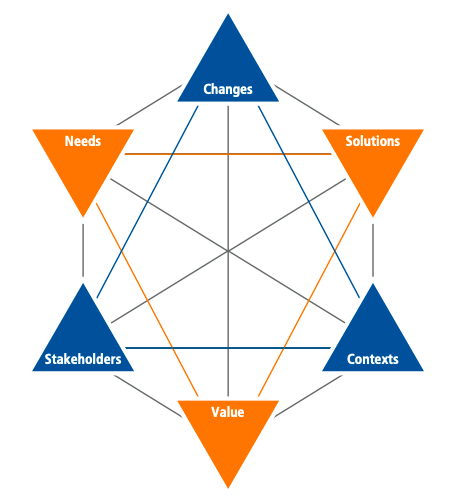Business Analysis Key Concepts Simplified based on BABOK Guide V3
The Business Analysis Core Concept Model (BACCM)
BACCM is a conceptual framework for business analysis. It explains what business analysis is and
what it means to those performing business analysis tasks regardless of perspective, industry, methodology, or level in the organization.
BACCM Consists of Six Core Concepts
- Change: The act of transformation in response to a need
- Need: A problem or opportunity to be addressed
- Solution: A specific way of satisfying one or more needs in a context
- Stakeholder: A group or individual with a relationship to the change, the need, or the solution
- Value: The worth, importance, or usefulness of something to a stakeholder within a context.
- Context: The circumstances that influence, are influenced by, and provide an understanding of the change.
- Each core concept is fundamental to the practice of business analysis
- All 6 concepts are equally important
- These concepts help to understand the type of information elicited, analyzed, or managed in business analysis tasks

Requirements Classification
Requirements can be classified using the below requirements classification schema
- Business Requirements
- These are statements of goals, objectives, and outcomes that describe why a change has been initiated.
- They are applicable for the whole of an enterprise, a business area, or a specific initiative.
2. Stakeholder Requirements
- These requirements describe the needs of stakeholders that must be met in order to achieve the business requirements.
- They act as a bridge between business and solution requirements.

3. Solution Requirements
- Describe the capabilities and qualities of a solution that meets the stakeholder requirements.
- The necessary details are provided via these requirements that allow for the development and implementation of the solution.
- These are two types of solution requirements
- Functional Requirements: Describe the capabilities of a solution
- Non Functional Requirements: Describe conditions under which a solution must remain effective or qualities that a solution must-have
4. Transition Requirements
- Describe the capabilities that the solution must have and the conditions the solution must meet to facilitate the transition from the current state to the future state
- These requirements are on a temporary basis
- They address topics such as data conversion, training, and business continuity
Stakeholders
A stakeholder is an individual or group that a business analyst is likely to interact with directly or indirectly. Any stakeholder can be a source of requirements, assumptions, or constraints.
BABOK guide describe the following roles as generic list of stakeholders.

- Business analyst
- A stakeholder in all business analysis activities
- Is responsible and accountable for the execution of all business analysis activities
- Customer
- Uses products or services produced by the enterprise
- Domain Subject Matter Expert
- Is any individual with in-depth knowledge of a topic relevant to the business need or solution scope
- This role is played by end-users, managers, process owners, legal staff, consultants etc
- End-User
- They directly interact with the solution
- Implementation Subject Matter Expert
- Any stakeholder who has specialized knowledge regarding the implementation of one or more solution components
- Implementation Subject Matter Experts include
- project librarian
- change manager
- configuration manager
- solution architect
- developer
- database administrator
- information architect
- usability analyst
- trainer
- organizational change consultant
- Operational Support
- Responsible for the day-to-day management and maintenance of a system or product
- Some operational support roles are
- operations analyst
- product analyst
- help desk
- release manager
- Project Manager
- Responsible for managing the work required to deliver a solution that meets a business need, and for ensuring that the project’s objectives are met while balancing the project factors including scope, budget, schedule, resources, quality, and risk
- Some project management roles are
- project lead
- technical lead
- product manager
- team leader
- Regulator
- Responsible for the definition and enforcement of standards
- Standards can be imposed on the solution via
- legislation
- corporate governance standards
- audit standards
- standards defined by organizational centers of competency
- Sponsor
- They initiate the effort to define a business need and develop a solution that meets that need
- Authorizes the work to be performed and control the budget and scope for the initiative
- Supplier
- They are outside the boundary of a given organization or organizational unit
- Provide products or services to the organization
- Tester
- Responsible for determining how to verify that the solution meets the requirements defined by the business analyst
- Conduct verification process
- Ensure that the solution meets applicable quality standards and that the risk of defects or failures is understood and minimized
Requirements and Designs

Key activities of a business analyst are eliciting, analyzing, validating, and managing requirements. However, it is important to recognize that business analysts are also responsible for the definition of design.
| Requirement | Design |
|---|---|
| Focused on the need | Focused on the solution |
| Techniques are used to elicit, model, and analyze requirements | Techniques are used to elicit, model, and analyze requirements |
| A requirement (or set of requirements) are used to define a design | Design is used to elicit additional requirements that are used to define more detailed designs |
| Business analyst work on requirements | Business analyst validates the design against the requirements |


